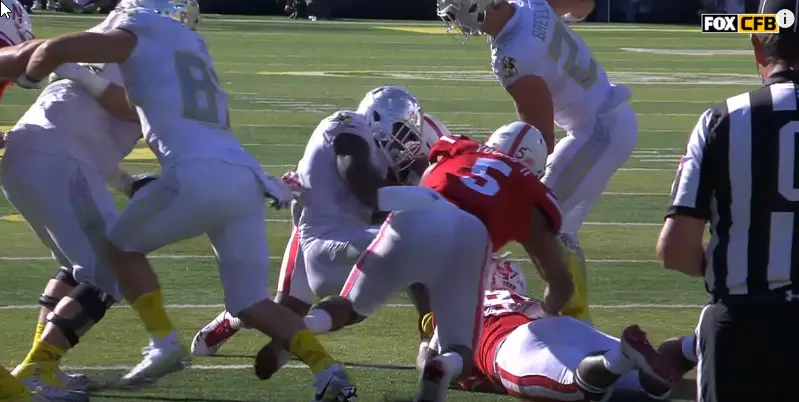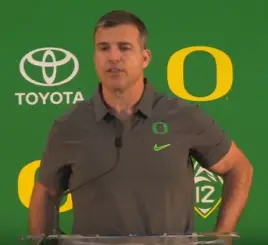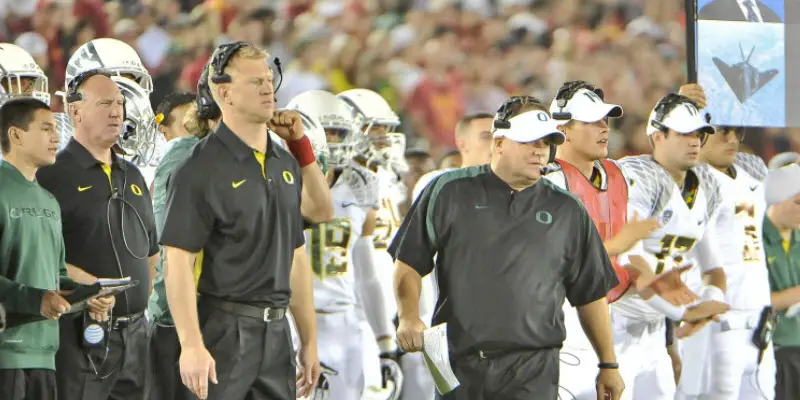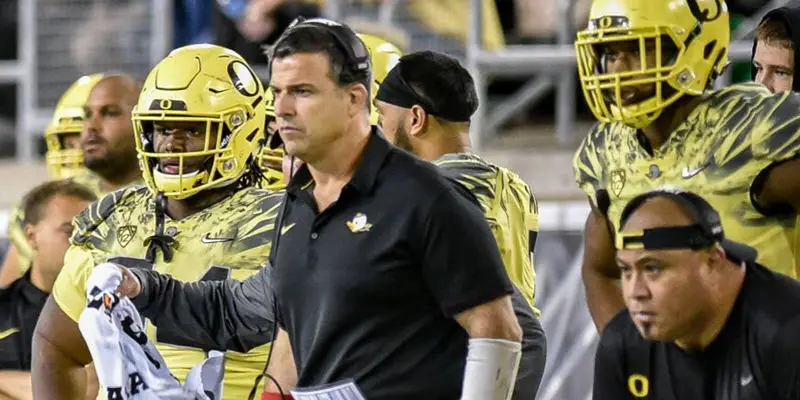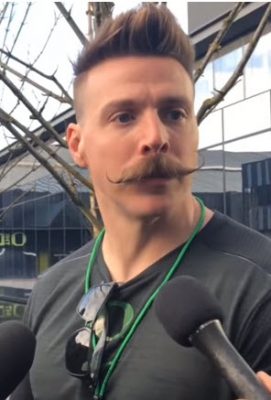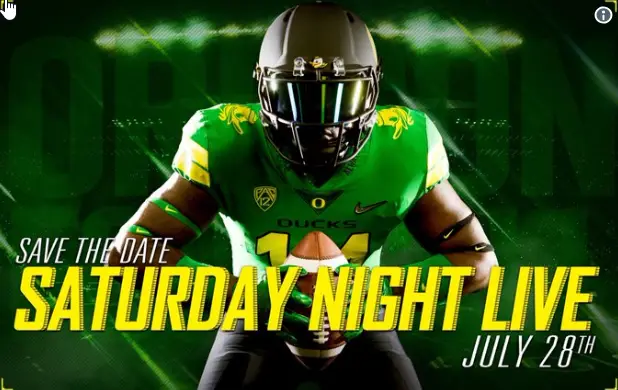BRUTAL SPEED: A Marriage Made in Heaven?
Mario Cristobal and Nebraska’s Scott Frost have expressed remarkably similar strategies to pursue a national championship.
This season, the two coaches plan to deliver two what-should-be-fascinating examples of combining Oregon speed and tempo tactics with brute-force football learned at Alabama and Nebraska. The goal: punish your opponents with dominating physicality, while simultaneously dazzling them into dizziness with speed and misdirection in new-age hybrid offenses.
“The elements of uptempo offense with the physicality at the line of scrimmage, it is very easily combined. We have been doing it,” says Cristobal, according to Andrew Greif‘s August 5 update.
“I always said at Oregon that if we could combine our scheme and speed there with old-fashioned Husker Power, that we wouldn’t lose a game,” Frost says in an interview with Bruce Feldman of Sports Illustrated.
Cristobal or Frost — or perhaps both — may be creating some of the most intriguing evolutionary developments of Oregon speed and tempo strategy since Chip Kelly.
Tweaking “Kelly-Ball” for Speed and Power
Both Cristobal and Frost want to improve on “Kelly-ball” and eliminate what they think were the weak points in Kelly’s approach. The book on Kelly, especially in the NFL, was that he gave away the play by his offensive formation. In Oliver Connolly‘s Landof10.com article Film Room: Scott Frost brings pace-and-space football to Nebraska, Connolly notes that both Cristobal and Frost are “part of the ‘post-Kellyism’ movement taking place throughout the college ranks.”
According to Cristobal in his interview with Greif: “Everyone’s gone uptempo and at the last place I was at [Alabama], we had to learn a lesson the hard way. People were going uptempo on us and all of a sudden we were getting outscored.”
Frost has the advantage of learning speed and tempo from Kelly himself. Connolly reminds us: “Frost credits his time on Chip Kelly’s Oregon staff [for his progression] to eventual spread-option evolutionist. ‘Him hiring me at Oregon and letting me learn his scheme, that changed my trajectory as a coach,’ Frost says of Kelly.’ … taking his offense and continuing to evolve it, that’s really gotten us (UCF) to where we are.'”
So, what are the key elements both of these coaches are focusing on? How will they compare? Will they both succeed to the point that Oregon and Nebraska even meet in the National Championship Title Game?
The Foundation: CULTURE – PHYSICALITY – RECRUITING
Cristobal and Frost are both emphasizing a similar multi-part foundation for their programs.
CULTURE
Both coaches put establishing a distinct team culture at the top of their priorities list — “The Oregon Way,” as Cristobal calls it, and “restoring the historic Nebraska Cornhuskers identity“ for Frost. Justin Hopkins reports in ScoopDuck: “Every coach, every player, every interview with Mario Cristobal preaches the change in culture with this team … I don’t think anyone can comprehend just how much he’s stressed it … This is a foundation element for the long-term success of Oregon football.”
Frost, likewise, feels he has to change the culture at Nebraska from the hangdog climate of fear and despair he inherited from Mike Riley to the confident, selfless culture he knew under Tom Osborne. “There’s a formula that worked at Nebraska for 30 years … the leadership on campus and the AD office ruined this place because it was either guys who thought, I wanna do it my way … or they didn’t understand what made Nebraska so good,” Frost says.
Frost’s No. 1 goal is restoring that culture and formula, to establish the right mindset in his players: “We will play with a desire to excel and no fear of failure. I want our guys to make big plays, splash plays, plays that impact the game and not worry about failing.” No fear of failure – Paul Myerberg.
PHYSICALITY
Strength, Conditioning and Scientific Nutrition (SCN): In football importance, just after the mental condition created by culture, comes a player’s physical condition. Cristobal and Frost demand the absolute best in SCN from their players, pushing them to exceed any limits they might think they have. Both have hired top-notch S&C coaches. Both have hired special nutritional consultants. And both teams are seeing dramatic improvements in their players’ size, speed and strength.
Hopkins says of Oregon S&C coach Aaron Feld: “Feld is the X-Factor. Just look at pretty much any player on the team, they are bigger, but also in tremendous shape … At the time it was hard to understand the true importance of this hire. But … these guys … are playing with better confidence and many are mentioning the differences in their bodies they can feel.”
To carry S&C to a higher technological level, “Oregon outfits every player with a GPS system to track every movement the players made during workouts,” according to Matt Prehm.
Frost’s priority on physicality stems from seeing up close how his 1990s Nebraska teammates dominated other teams. When he arrived at Nebraska in 2017, he was surprised at how out of shape some players were, and at the deficiencies in the S&C program. He set about correcting that immediately. Meyerberg quotes Frost: “The formula at Nebraska is going to be hard work and developing players better than everybody else.” Will Cristobal at Oregon or Frost at Nebraska have the biggest, strongest and fastest team in college football?
RECRUITING
Cristobal is a star recruiter and so are his assistant coaches. As OC Marcus Arroyo put it, “We recruit like monsters!” Most of us have been following Oregon’s recruiting success closely. The question for Oregon, however, is how these young men will perform on the field. As Hopkins reports, Cristobal himself acknowledges “If your culture is strong and you match it with great personnel, it’s a recipe for success … it’s not just about signing four- and five-star recruits.”
Frost, while acknowledging the importance of recruiting, is supremely confident in his ability to develop lower-ranked players. (Remember, Marcus Mariota was a three-star recruit.) He feels that as long as Nebraska’s recruiting rankings are in the Top 25, he will be ok. Myerberg quotes in Frost’s blueprint: “The formula at a lot of places is to recruit five stars and throw them on the field and hope you out-recruited everybody … Over and over I see three-star kids that end up being better players in college than kids that were hyped up and five-star recruits … our mission is to do better with them once they hit campus.“
Who is more right about recruiting versus development, Cristobal or Frost?
Conclusion
Both Frost and Cristobal are instilling the foundational elements of Culture, Physicality and Recruiting to create what they hope will be national-championship caliber programs. Once the foundations are in place, how is the Power plus Speed equation going to play out in game-day strategy for both Cristobal and Frost? Will they be borrowing concepts from one another, as Kelly often did and Cristobal does from his time at Alabama? Could Frost provide more offensive concepts for Oregon, even though he’s now at Nebraska?
Walter Gray
Papillion, Nebraska
Top Photo Credit: Fox Sports via YouTube
Walter Gray was born in Washington DC; but, thankfully, grew up on the Outer Banks of North Carolina. Sun, sand, the ocean and hurricanes. He’s tri-coastal in his college degrees – College of the Albemarle NC (AA), UofO (BA 1975), Rice University in Houston (Master of Architecture) – and has lived all over the USA.
While in graduate school at Rice he started an architectural bookselling and publishing company, which he ran for years, with customers around the world. Then, he became involved in consulting with smaller IT software companies to help them grow. Now at 70 he grows and designs his garden. He and his wife Debra live in Papillion NE. His daughter Kelsey is a Lewis & Clark College graduate and lives in Portland. He loves to conceptualize new approaches to an issue or problem.
Since the 1990’s, he’s been increasingly hypnotized by the Oregon Ducks and especially loved watching Chip Kelly’s teams with their explosive unpredictability. He’s neither a “football analyst” nor a “football writer”. But, because of his architectural design education, he is someone who enjoys developing ideas that he finds intriguing.

